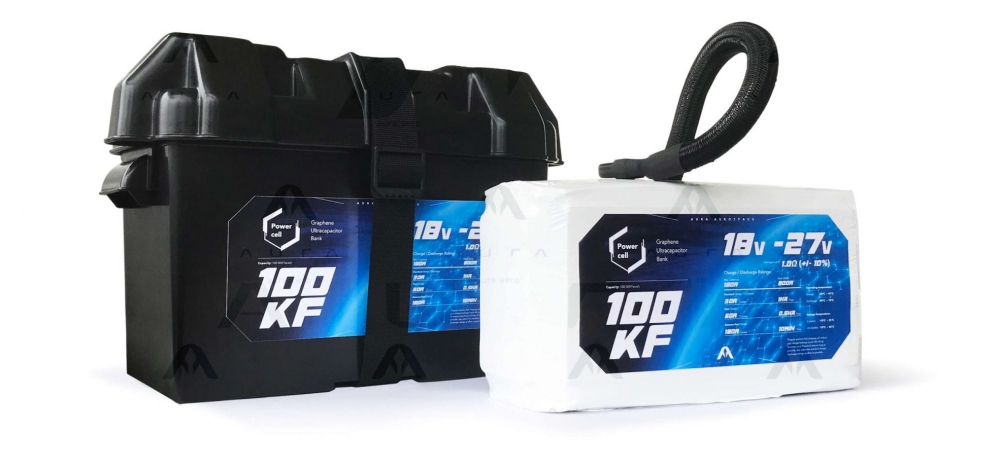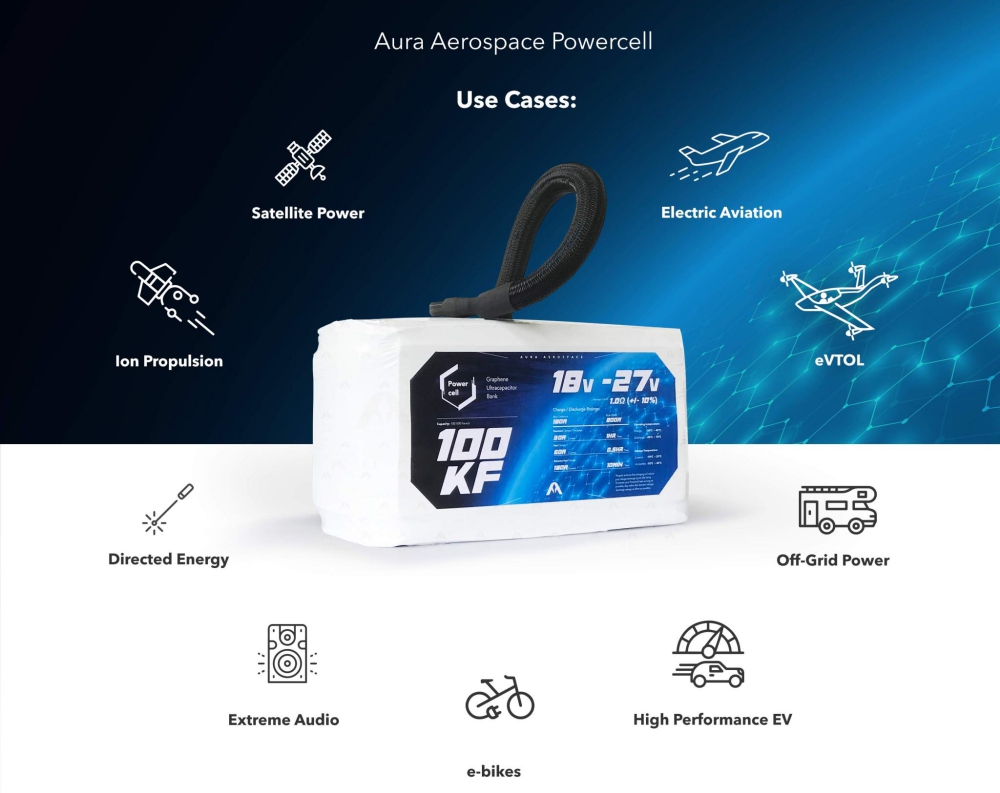For many years traditional battery development has been optimizing for capacity, slowly increasing usable EV range, while still working within chemistry constraints that limit peak power output and charge time.
On the other end of the spectrum, we have had very fast charge/discharge capacitors, with historically limited capacity, slowly being optimized for capacity and EV range.
By using high capacity ultracapacitors, Aura’s Powercell breaks the power supply paradigm, increases immediate power response, and decreases charge time – which is crucial for our application: electric vertical take-off and landing (eVTOL) aircraft. Rather than focusing on heavily extending capacity/range (which is better achieved by fuel cells at this time) our goal is to deliver massive amounts of power as quickly as possible.
Using Aura’s Powercell in a hybrid configuration with hydrogen fuel cells or internal combustion generators, will provide the massive burst power required by launch or takeoff, at levels that generators or fuel cells simply cannot deliver.
Higher performance
At the moment of take-off, electric VTOL aircraft require huge bursts of energy that are rarely required once in forward flight. Using one battery chemistry to perform both tasks, at this time, still compromises performance on both sides. Making use of a high capacity generator (such as hydrogen fuel cells) to provide the energy for forward flight with Aura’s Powercell as a high power storage bank for take-off and landing requirements, outperforms the potential of battery based solutions.
Similar energy demands apply to most electric vehicles, especially larger electric trucks. The power required to move from a standing start is much more than what is needed to keep it rolling – meaning a hybrid configuration using Aura’s Powercell will be more energy and cost efficient over the vehicle’s useful life.
The important principle is the difference between Energy Density (Ah/lbs, or Wh/kg) and Power Density (hp/lbs, or kW/kg).
Using a Tesla car as an example;
– The Energy Density of your battery pack limits your range.
– The Power Density of your battery pack limits your acceleration rate (i.e. 0-60 time).
Swapping the traditional lithium battery in a Tesla with an equivalent mass Aura Powercell would double the available power and result in lower 0-60 times.
When applied to eVTOL aircraft Aura Powercell based power systems can provide faster take-offs and safer landings by having power density levels significantly higher than the batteries used now.
Our goal is to break the paradigm of a quick discharge capacitor and create an energy storage device that operates just like a battery – resulting in a usable, practical solution that performs above and beyond any chemical battery ever made.
Useful Lifespan
‘Cycle life’ is the term used to define the useful lifespan of a rechargeable power source, meaning; how many times can it be charged and recharged before it loses its performance or capacity?
In the case of high performance drone lithium-polymer batteries (liPo), this is only 200 cycles. Lithium-Ion (li-ion) batteries can perform well up to 1000 cycles. Some lithium chemistries are capable of up to 2000 cycles.
While this may seem like a lot of run-time, the Aura Powercell is rated for 250,000 cycles.
This order of magnitude increase in cycle life compared to batteries will significantly decrease battery replacement costs over the life of a product or vehicle. Ongoing battery replacement dramatically increases the cost of ownership, as well as significantly impacting environmental sustainability.
Aura’s Powercell is the only choice for dependable, long life products, electric vehicles, and aircraft.
Intrinsically Safe. So much safer than batteries, it can be carried by air transport.
Anyone familiar with the dangers of lithium batteries at the smaller scale, can imagine the implications in a passenger rated electric aircraft – much bigger fires, huge explosions, uncontrollable thermal runaway – all potentially caused by an undetectable cell manufacturing defect. These risks contribute to the current restrictions we see on air transport of lithium batteries.
Put simply, this is not the case with Powercell. Ultracapacitor technology is so safe, it can be legally carried by air transport, unlike lithium batteries. Powering an electric aircraft with a lithium battery not even safe enough to be carried as cargo in an aircraft does not establish an efficient end to end supply chain.
Aura’s Powercell enables a faster, more responsive technology ecosystem for your vehicle or innovation, as well as safe operation throughout it’s useful life.
Zero cobalt and 90% recyclable
Cobalt is used in almost all lithium batteries today to increase energy density and cycle life, and it is one of the most destructive metals on earth in terms of its human rights impact. It is often mined under conditions that violate human rights, simply to increase capacity of lithium batteries to gain an extra hour of run-time for a given device or vehicle.
To create technologies that better the lives of some, while destroying the lives of others is not sustainable in the long term.
Aura’s Powercell is made primarily of aluminum foil and graphene, containing zero cobalt.
At the end of its lifespan, it can be melted down, recycled back into its base materials, and those base materials are then used to make more Powercells. Our supply chain is sustainable and in the future, can be re-structured to use 100% post industrial and consumer waste.
Source: Press Release


